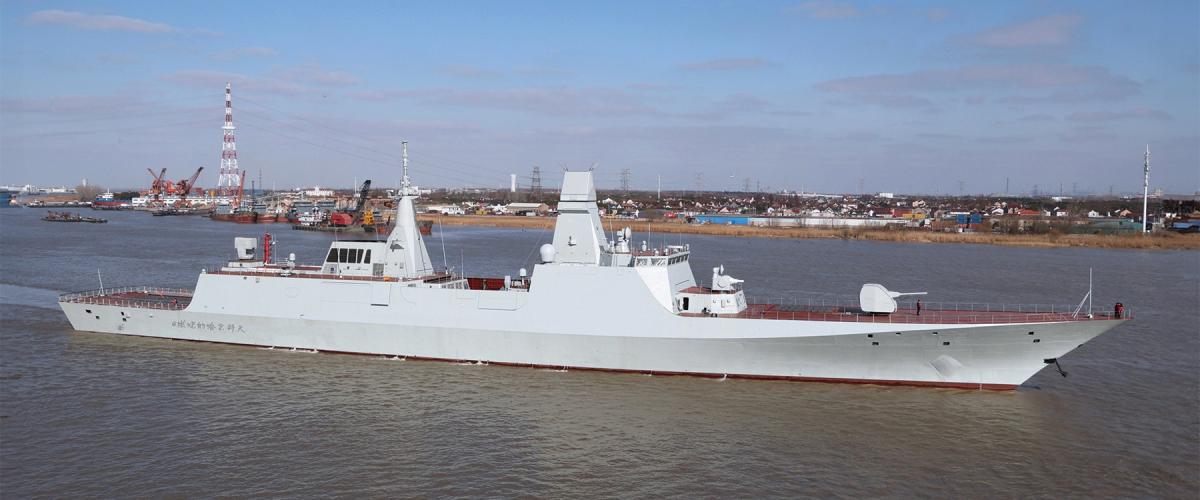For the People’s Liberation Army (PLA), the biggest surprise of 2023 was the end-of-year announcement that Admiral Dong Jun, chief of the PLA Navy (PLAN), had been appointed as the 14th Minister of Defense.1 News of Admiral Dong’s appointment was overshadowed in Western media by the mystery surrounding the removal of his predecessor, Army General Li Shangfu. But the first-ever appointment of a career PLAN officer as head of the PLA is a testament to the importance Chairman Xi Jinping and the Chinese Communist Party (CCP) have placed on transforming China into a great naval power to achieve the so-called Great Rejuvenation of China. Toward that end, growth has continued in the number of ships, submarines, and naval aircraft and their operations at sea.
An Admiral at the Helm of the PLA
The significance of Admiral Dong’s appointment should not be underestimated, as it represents the culmination of 25 years of PLAN modernization and growth—from being a brown-water force to an institution whose top officer is now leading China’s entire military. The appointment is important for two principal reasons.
First, Admiral Dong is one of the PLA’s most experienced joint commanders, having deep expertise at the operational level of war in the Eastern and Southern Theater Commands that provides him with unique understanding and perspectives regarding China’s disputed sovereignty claims—cross-domain but fundamentally maritime issues.2
Second, and perhaps more important, Admiral Dong has the distinction of being the first Commander of the East China Sea Joint Operations Command Center (ECS JOCC), having served from July 2013 to November 2014 while he served as one of the deputy commanders of the East Sea Fleet. Established in 2013, the ECS JOCC was the PLA’s first joint operations command headquarters responsible for the operational coordination of the PLAN, PLA Air Force (PLAAF), and other forces—including the China Coast Guard and Strategic Rocket Forces—against Taiwan.3 Admiral Dong’s various appointments should be a reminder of the importance the CCP places on the PLAN and the PLA’s overall capability to take Taiwan by kinetic means should other efforts fail.
Growth Continues
While recent economic problems have slowed PLAN ship production over the past two years, Chinese reporting indicates the PLAN commissioned its eighth Type 055/Renhai-class cruiser, eight more Type 054A/Jiangkai II frigates, and one comprehensive submarine rescue ship.4 In addition, the PLAN launched one Type 075/Yushen-class amphibious assault ship, five cruisers and destroyers, two newer Type 054B frigates, and three nuclear-powered submarines. The total tonnage launched and commissioned in 2023 was about 170,000 tons, compared with 110,000 tons in 2022, although still somewhat lower than the 200,000-ton annual average prior to the COVID-19 pandemic.
While China acknowledged this slight decrease, it claims to have achieved a “significant increase in quality,” particularly with the Type 054B frigates that began sea trials in January 2024.5 Despite producing fewer hulls and less tonnage, the PLAN remains the world’s leader in new commissionings by tonnage—as it has for at least five years. Expected U.S. shipbuilding growth in the coming years probably will not improve this worrying strategic trendline.
The Workhorse Shandong
While PLAN carrier strike groups (CSGs) today are not of the same caliber as the U.S. Navy’s, a mere 11 years after the first PLANAF fighter recovered on the deck of the Liaoning, China’s second aircraft carrier, the Shandong, was conducting “live-fire confrontation drills” in the South China Sea in January 2023.6 Operations included nighttime launch-and-recoveries as the carrier achieved the first of what would become an unprecedented number of at-sea periods for any PLAN carrier, rivaling days at sea by any U.S. carrier in the western Pacific for the year.
In April, the Shandong CSG—which included a Type 055 cruiser, a Type 052D destroyer, two Type 054A frigates, and two comprehensive replenishment ships (a Type 901 and a Type 903)—was back at sea passing through the Bashi Channel and into the waters east of Taiwan. There, it participated in exercise Joint Sword with the PLAAF, PLA Strategic Rocket Forces, and surface combatants that encircled the island of Taiwan from 8 to 10 April.7 Following Joint Sword, the Shandong moved to an area 350 nautical miles west of Guam, close to where the Liaoning had operated just four months prior.8
According to observations by Japan’s Ministry of Defense, during 18 days of operations in the western Pacific, the Shandong conducted 620 aircraft sorties (fixed-wing and helicopter), far exceeding the 320 sorties the Liaoning conducted over 15 days in December 2022.9
Then, in September, the Shandong CSG entered the western Pacific via the Bashi Channel at the same time as a large number of PLAN warships were observed passing through the Miyako Strait into the Philippine Sea. Overall, some 20 PLAN warships were detected, the most ever tracked around Taiwan in a single day.10
A little more than a month later, the Shandong CSG was back at sea in the western Pacific, where it conducted nine days of operations that included 570 aircraft sorties—an average of around 63 aircraft sorties a day. This is nearly twice the number carried out in April and three times the sortie rate recorded by the Liaoning in January.11
Not done, in December the Shandong CSG returned to its homeport in the South China Sea via the Taiwan Strait following a month-long operation in the Bohai Sea, where the Shandong had helped train pilots from the Liaoning while the latter was in port for maintenance.12 While not as rigorous as that of the U.S. Navy’s carrier force, this level of at-sea training is evidence of the PLAN’s rapid growth in capability.
The PLAN’s third carrier, the Fujian, completed mooring trials and began dead-load testing of her three electromagnetic catapults in November. She will likely begin sea trials in summer 2024. It seems clear that, while much of the world questions the efficacy of aircraft carriers because of the proliferation of anticarrier missile systems, the PLAN is doubling down on them.
Russia and Iran
Over the course of 2023, the PLAN continued its long-standing coordinated operations with the Russian Navy. In July, the two navies held joint exercises in the Sea of Japan. For the second year in a row, PLAN and Russian warships conducted a “show of force” when 11 warships transited eastward through the first island chain in August. Ties between Xi and Russia’s Vladimir Putin have grown, and these combined naval operations have expanded, even as the Russian invasion of Ukraine continues.13
In addition, the PLAN conducted two trilateral exercises with the Russian and other navies. The first occurred in February, when the PLAN’s 42nd Escort Task Force (ETF) participated in exercise “Mosi II” along with host South Africa’s Navy.14 Then in March, the PLAN’s 43rd ETF conducted the trilateral exercise “Security Belt” with the Russian and Iranian navies. These events are a stark reminder of the alternative international order Beijing, Moscow, and Tehran want to establish in the name of anything but maritime economic security.
Preparing for War at Sea
The appointment of Admiral Dong to lead China’s Ministry of Defense means that Xi and the CCP have undeniably recognized the importance of maritime power to complete the Great Rejuvenation of China. The CCP has handed over the leadership of the PLA to a man who views the world through the lens of war at sea. Recall that, in December 2022 while still head of the navy, Dong held a conclave of senior PLAN officers. The gathering could be reduced to a single, critically important theme: “Make all necessary preparations to defeat the U.S. Navy in great power war at sea.”15 Admiral Dong’s appointment will affect the entire PLA in the next year and throughout the remainder of this so-called decade of concern.
1. CDR Mike Dahm, USN (Ret.), “Who’s Hu, the New PLAN Commander,” U.S. Naval Institute Proceedings 149, no. 12 (29 December 2023).
2. Andrew S. Erickson and CAPT Christopher Sharman, USN (Ret.), “Admiral Dong Jun Engages Friends and Foes: China’s First Naval Defense Minister Brings Joint Operational Experience,” China Maritime Studies Institute, 30 December 2023, 1.
3. Erickson and Sharman, “Admiral Dong Jun Engages Friends and Foes,” 2.
4. Tan Yusheng, “2023 Review of the Chinese Navy’s Equipment Development in 2023 [Original in Chinese],” Naval and Merchant Ships no. 2 (2024): 66–75.
5. Yusheng, “2023 Review of the Chinese Navy’s Equipment.”
6. “Highlights of Aircraft Carrier Shandong’s Live-Fire Drill in South China Sea,” PLA Daily, 16 January 2023.
7. Liu Xuanzun, “China’s Aircraft Carrier Shandong Holds Intensive Drills Comparable with Liaoning in West Pacific,” Global Times, 18 April 2023.
8. “Chinese Aircraft Carrier Nears U.S. Territory of Guam,” Radio Free Asia, 30 December 2022.
9. Liu Xuanzun, “China’s Shandong Aircraft Carrier Group Collaborates with Rocket Force, Land-Based Aviation Forces in 1st Far Sea Exercise,” Global Times, 7 May 2023.
10. Keoni Everington, “Chart Shows Chinese ‘Unprecedented’ Carrier Exercises around Taiwan,” Taiwan News, 18 September 2023.
11. Liu Xuanzun, “PLA’s Carrier Shandong Doubles Aircraft Sortie Rate Record in Latest Far Sea Drill,” Global Times, 7 November 2023.
12. Liu Xuanzun, “PLA’s Aircraft Carrier Shandong Transits Taiwan Straits after Operation in the North,” Global Times, 12 December 2023.
13. John Feng, “Map Shows Chinese Navy Ships Heading for Possible Russia Meet,” Newsweek, 19 March 2024.
14. Jay Gates, “Arrival of Chinese Navy Taskforce in Cape Town a Sign of Closer China/SA Ties,” Defence Web, 31 July 2023.
15. Ryan D. Martinson, “Winning High-End War at Sea: Insights into the PLA Navy’s New Strategic Concept,” Center for International Maritime Security, 18 May 2023.




